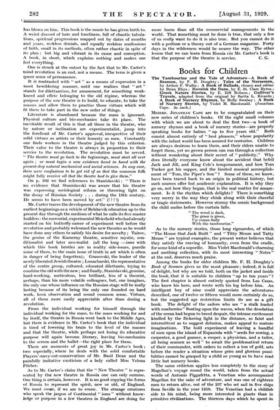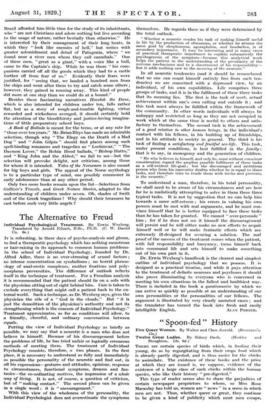Books for Children
The Tambourine and the Tale of Adventure—A Book of Seamen, by F. H. Doughty ; Tales of the Norsemen, by Arthur F. Wallis ; A Book of Ballads, chosen and edited by Brian Rhys ; Havelok the Dane, by E. St. Clare Byrne ; Greek Nature Stories, by E. Riff Robson; Gulliver's Travels, adapted from the original by Smite L. Ricardo: A Book of Nursery Rhymes, by Molly Swabey ; A- Book of Nursery Stories, by Violet M. Macdonald. (Jonathan Cape. 3s. each.) MESSRS. JONATHAN CAPE are to be congratulated on their new series of children's books. Of the eight small volumes
with which we are about to deal the first two—a book of nursery rhymes and a book of nursery stories—are properly speaking books for babies "up to five years old." Both consist almost entirely of "best pleasers," whose popularity with the infant world has been assured for centuries. Children are always desirous to learn them, and their elders unable to
forget them, yet no grown person can run through a collection without wondering about their secret of ." publicity." Why does literally everyone know about the accident that befell Jack and Jill, and King Cole's temperament, and how, Tom Tucker got his supper, and the limited musical accomplish- ment of "Tom, the Piper's Son" ? Some of these, we know, have been traced back to an origin in political history, but such sources offer but academie.explanation. It is wk they go on, not how they began, that is the real matter for amaze- ment. Is it the rhythm which delights? There, is something very merry in the way they chink along with their cheerful or tragic statements. However stormy the scenic background the child smiles before the curtain falls.
"The wood is dark, The grass is green, UP comes Sally With the tambourine."
As to the nursery stories, those long rigmaroles, of which "The House that Jack Built" and " Titty Mouse and Tatty
Mouse" are typical examples, the present writer believes that they satisfy the craving of humanity, even from the cradle, for some kind of a soporific. Miss Violet Macdonald's charming
and soothing collection, with- its most interesting "Notes" at the end, deserves much praise.
Among the books for older children Mr. F. H. Doughty!s
Book of Seamen gives us the most pleasure ; indeed, it is full of delight, but why are we told, both on the jacket and inside the book, that it is suitable to children "up to ten years" ?
The first chapter is almost entirely quoted from Las Casas, who knew his hero, and wrote with his log before him. An intelligent boy of nine could appreciate the adventures described, one of twelve or fifteen would more certainly do so, but the suggested age restriction limits its use as a gift book. The delight of the sailors who see "a stalk loaded with roseberries " floating upon the waves, when the desolation of the ocean had begun to breed despair, the intense excitement kindled by the flickering light in the distance, so faint and intermittent as to suggest delusion, makes appeal to mature imaginations. •The bold experiment of leaving a handful of men upon the island of Espaniola with "seeds for sowing, a carpenter, a good gunner, a cooper, a physician, and a tailor, all being seamen as well" to await the problematical return of their commander, with orders to collect a ton Of gold, sets before the reader a situation whose grim and glorious possi- bilities cannot be grasped by a child so young as to have read little but nursery books.
The same criticism applies less completely to the story of Magellan's voyage round the world, taken from the actual words of Antonio Piggafetta, a Venetian who accompanied Magellan for the sake of adventure, and was one of eighteen men to return alive, out of the 237 who set sail in five ships from Seville in the year 1519. The Venetian had a childish side to his mind, being more interested in giants than in primitive civilizations. The thirteen days- which he spent 4n Brazil afforded him little time for the study of its inhabitants, who "are not Christians and adore nothing but live according to the usage of nature, rather bestially than otherwise." He is interested by their management of their long boats, in which they "look like enemies of hell," but writes with greater astonishment and detail of Patagonia, where "we found near a river men whom they call cannibals." One of these men, "great as a giant," with a voice like a bull, came to the Captain's ship. While he was there "his com- panions carried off all the goods which they had to a castle further off from fear of us." Evidently their fears were justified, for "seeing that, we landed a hundred men from the ships and went after them to try and catch some others ; however, they gained in running away. This kind of people did more at one step than we could do at a bound."
Besides these fascinating narratives Havelok the Dane, which is also intended for children under ten, falls rather flat, but as a story of rough-and-tumble fighting, virtue rewarded and wickedness avenged, it should certainly hold the attention of the bloodthirsty and justice-loving imagina- tions of little preparatory school boys.
A Book of Ballads is meant for the teens, or at any rate for "those over ten years." Mr. Brian Rhys has made an admirable selection, though why "The Elegy on the Death of a Mad Dog" and "John Gilpin" should find places among such spell-binding romances and tragedies as " Lochinvar," "The Daemon Lover," the Robin Hood ballads, "Bishop Hatto," and "King John and the Abbot," we fail to see—but the selection will provoke delight, not criticism, among those for whom it is intended. Tales of the Norsemen is also meant for big boys and girls. The appeal of the Norse mythology is to -a particular type of mind, one possibly commoner in early adolescence than at any other period.
Only two more books remain upon the list—Selections from Gulliver's Travels, and Greek Nature Stories, adapted to the Understanding of children under seven. Oh, shades of Swift and of the Greek tragedians! Why should their treasures be cast before such very little angels ?

































 Previous page
Previous page